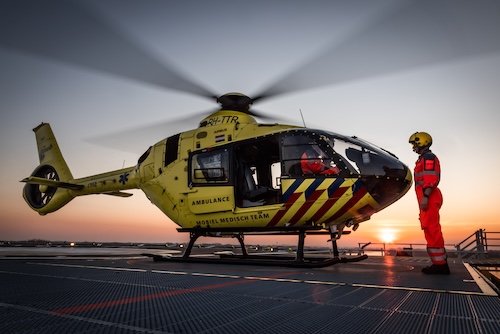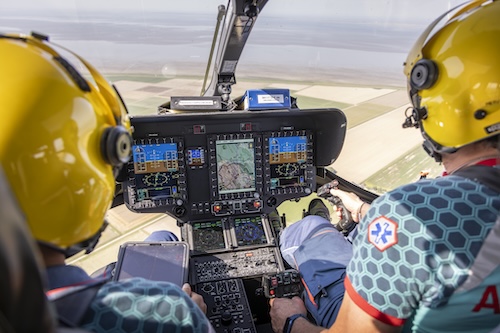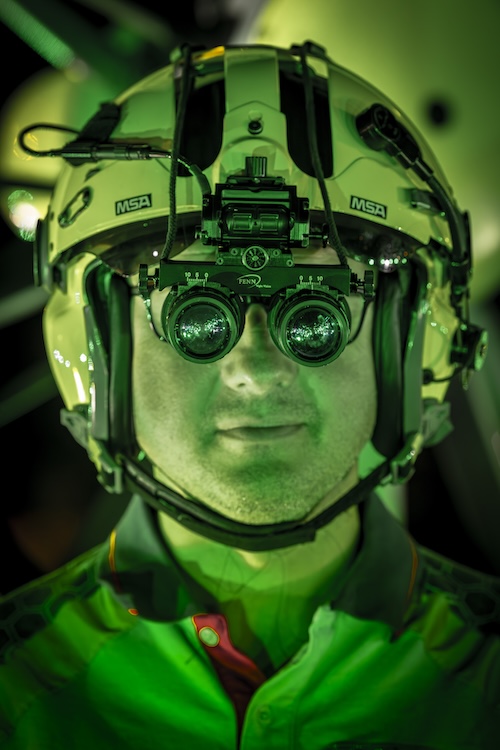|
Sep
08
2025
|
|
Posted 125 days ago ago by Admin
|
|

With no fewer than 12,000 calls per year, the familiar yellow trauma helicopters are a frequent site in the Netherlands’ skies. Onboard is a Mobile Medical Team (MMT), consisting of a pilot, a doctor, and a paramedic, racing to any medical emergency where seconds count.
Although we’ve become accustomed to helicopters responding to serious accidents, this form of emergency medical service is still relatively new in the Netherlands. In Germany, however, doctors were already sounding the alarm in the late 1960s due to a rapidly increasing number of traffic fatalities. To improve survival chances, it was essential not only to reach accident scenes more quickly but also to transport patients to trauma centers faster. The ADAC (Allgemeiner Deutscher Automobil-Club) took the initiative to conduct trials using rented MBB Bö-105 helicopters. The results were so promising that, in November 1970, the first permanent civilian rescue helicopter was stationed in Munich. In the years that followed, the number of locations grew significantly. Partly thanks to the success of the German network of military and civilian rescue helicopters, interest in establishing a similar service in the Netherlands grew in the mid-1980s—especially as traffic in the Randstad region became increasingly congested.

The First Steps
With support from the ADAC, the ANWB launched a pilot project on 1 May 1995 in close cooperation with the VU University Medical Center in Amsterdam (now Amsterdam UMC). The medical crew was provided by the hospital, the helicopter—a MBB Bö-105—and pilots were contracted from KLM-ERA Helicopters, and funding and logistics were arranged by the ANWB. This marked the birth of the first civilian trauma helicopter in the Netherlands, aptly named Lifeliner 1. To manage this new operation, a dedicated subsidiary was established: ANWB Medical Air Assistance, or ANWB MAA. In 1997, a second helicopter (again an MBB Bö-105) was stationed at Erasmus Medical Center in Rotterdam. This aircraft was named Lifeliner 2.
Expanding the Network
With just two helicopters, both located in the western part of the country, it was difficult to provide adequate national coverage. This led to efforts to expand the HEMS (helicopter emergency medical service) operation. In 1998, the Dutch Ministry of Health, Welfare and Sport (VWS) committed to supporting the continuation of the service. Meanwhile, ANWB MAA established agreements with the 11 designated trauma centers across the Netherlands, enabling the helicopters to land there. In 2004, the first five brand-new Eurocopter EC-135 helicopters were delivered, replacing the older MBB Bö-105s. At the same time, two new permanent bases were opened: at Volkel Air Base (Lifeliner 3), where the medical crew was provided by Radboud University Medical Center in Nijmegen, and at Groningen Airport Eelde (Lifeliner 4), staffed by medical personnel from the University Medical Center Groningen (UMCG). With the arrival of the EC-135s, night-flight testing also began. Following an extensive training and evaluation phase, the Ministry of Health approved 24-hour trauma helicopter operations by ANWB MAA in 2011.

Busy Operating Area
With an average of 12 missions per day, Lifeliner 1 is one of the busiest trauma helicopters in the Netherlands. The primary service area of Lifeliner 1 includes the densely populated northwest of the Netherlands. However, the helicopter is regularly deployed outside its designated region when other teams are already engaged and a Mobile Medical Team is urgently needed elsewhere. “Currently, Lifeliner 1 is staffed by eight pilots and 11 HEMS crew members (HCMs),” says Frans Fuhrmann, chief pilot of Lifeliner 1 and deputy flight operations manager. “These HCMs are emergency or ambulance nurses who have received additional flight operations training at ANWB MAA and can assist the pilot during missions. In addition, we have 14 doctors and 13 helicopter landing officers, who also drive the MMT ground vehicle. This vehicle is used when flying is not possible due to weather conditions, when the helicopter is unavailable due to maintenance, or when the incident can be reached faster by road.”
A Challenging Job
“Since 2008, I have been chief pilot of Lifeliner 1 and have accumulated around 1,800 flight hours on many different aircraft and helicopters, including the Sud Aviation Alouette III, Westland UH/SH-14D Lynx, Dornier Do-228, and Airbus EC-135/H135. Working on the trauma helicopter was my preference when I left the Navy. The work on the trauma helicopter is challenging. We sometimes fly in poor weather and land in places you normally wouldn’t reach by helicopter, so finding a suitable landing spot—often in densely built-up cities—is crucial. What really appeals to me is working in a multidisciplinary team and being part of the emergency response. It’s varied and sometimes demanding to achieve a good and safe outcome with the team.” says Fuhrmann.

Wadden Sea Helicopter
ANWB MAA currently operates six EC-135/H135 helicopters as well as two Airbus H145 helicopters. The H145s were acquired in 2016 after the Royal Netherlands Air Force retired its three Bell 412SP helicopters in January 2015. These helicopters had performed Search and Rescue (SAR) missions from Leeuwarden Air Base with 303 Squadron. This special SAR squadron, active since 1977 from Leeuwarden and previously flying the Sud Aviation Alouette III, primarily rescued downed military pilots around the Wadden Islands’ shooting ranges. Over time, patient transport from the Wadden Islands to the mainland became an increasingly important secondary task. When the Ministry of Defense announced in 2014 it would disband the squadron, patient transport services to and from the Wadden Islands were at risk. Defense guaranteed the transitional period until a civilian party could be contracted through a public tender to take over the transport for the Regional Ambulance Service Friesland (RAV Fryslân). The ANWB MAA eventually won the tender, partly because their offer of the Airbus H145 was both economically and practically more suitable for the task. The Airbus H145 is significantly larger than the EC-135/H135, providing space next to the pilot for one patient, one nurse, and two extra seats for a doctor, family member, or instructor. The ANWB H145s also feature a ‘Helionix’ avionics suite, a dual-duplex, four-axis autopilot, and a ‘Bucher’ medical interior.
With the call sign Medic 01, the ANWB MAA’s H145s have been based at Leeuwarden Air Base since November 2016. Staffed by seven pilots, ten HCMs, and 13 nurses from RAV Fryslân. “Flying the ambulance helicopter in the Wadden region involves many challenges. Obviously, the weather—storms, snow, fog, high summer heat—but also a wide variety of patients, from broken bones to resuscitations. Finding suitable landing spots is also challenging; beaches, dunes, campsites, and bike paths are almost daily landing zones. This is only possible if the weather at the landing site is good. We are the only ANWB MAA base authorized to fly on instruments through clouds. The Wadden region has unique weather phenomena that can differ greatly from the mainland. It can be beautiful weather on the Wadden, but bad on the mainland and vice versa. When visibility over water is poor, the grey sky and grey sea blend together, making it hard to distinguish up from down, which can cause disorientation. We then rely heavily on our instruments to confirm we are flying correctly. We are well trained for this. When it’s windy in the Netherlands, it is usually even windier in the Wadden, making takeoffs and landings more challenging,” explains Michael Zwollo, former Royal Netherlands navy pilot on the Westland Lynx and NH-90 and now chief pilot of Medic 01 and coordinator of flight operations at Leeuwarden Air Base.

Lelystad
Since 2012, the headquarters of ANWB Medical Air Assistance has been located at Lelystad Airport. The organization employs a total of 57 people, including 37 pilots (of whom two partly hold management positions at the office), two technicians, 13 office staff, and five employees working at ANWB Medical Drones. The location is special due to its central position, which is crucial when reserve capacity needs to be deployed in case of technical problems at any of the other bases. Additionally, the airport offers the opportunity to conduct training and maintenance flights with reserve helicopters in a relatively sparsely populated area.
“Initial training takes place in Lelystad for both helicopter types. Once this part is completed, trainees continue their training ‘on the line.’ Regular ground training sessions also take place here (first aid, technical refreshers, crew resource management (CRM), etc.). Flight recurrent training is conducted on simulators. After completing the initial training and the Operational Proficiency Check (covering operational flight procedures), the pilot moves to their own base for further training to become a HEMS pilot. The training between a trauma pilot and an ambulance pilot is almost identical, with the key difference that the latter also operates IFR flights and must be trained accordingly on type and operations,” explains Amanda Tijben, flight operations manager at ANWB MAA.

The Future
Since August 2023, Bastiaan Kroes has been the director of ANWB Medical Air Assistance (ANWB MAA). “The unique combination of aviation, helicopters, emergency services, and social commitment was decisive for me to make the switch to ANWB MAA,” says Kroes. “2024 was a busy year, with the helicopters and Mobile Medical Teams being dispatched 12,000 times. Our ambulance helicopter received 818 calls in 2024, and together our ‘Lifeliners’ and ‘Medic’ helicopters logged 3,800 flight hours during these missions. ANWB MAA has recently also launched ‘ANWB Medical Drones.’ With this, we are working on a medical network for transporting blood samples, medicines, and lab results by drone. Additionally, we test transport conditions by monitoring temperature, vibrations, etc., and assess their effects on the products being transported. Our biggest challenge is getting the regulations in place. This requires close collaboration with, among others, the Ministry of Infrastructure and Water Management, LVNL (air traffic control for the Netherlands), and the drone industry,” Kroes explains. Amanda Tijben adds, “We are of course proud to have carried out these important tasks for the trauma centers and RAV Fryslân for 30 years now, thereby making a valuable contribution to the quality of patient care in the Netherlands.”
Acknowledgments
The authors would like to thank ANWB MAA for their cooperation and hospitality in the preparation of this article.
READ JUL/AUG ISSUE OF ROTOR PRO
READ MORE ROTOR PRO: https://justhelicopters.com/Magazine
WATCH ROTOR PRO YOUTUBE CHANNEL: https://buff.ly/3Md0T3y
You can also find us on
Instagram - https://www.instagram.com/rotorpro1
Facebook - https://www.facebook.com/rotorpro1
Twitter - https://twitter.com/justhelicopters
LinkedIn - https://www.linkedin.com/company/rotorpro1